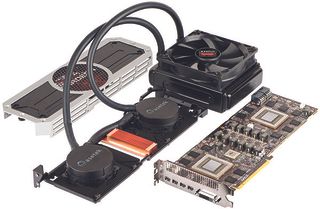Radeon R9 295X2 8 GB Review: Project Hydra Gets Liquid Cooling
“Do you have what it takes?” AMD asks, purportedly referring to the big budget and beefy power supply you need before buying its new Radeon R9 295X2. We benchmark the 500 W, dual-GPU beast against several other high-end configs before declaring a winner.
Power And Design Decisions
Power Consumption, By The Numbers

Notice the two eight-pin power plugs? A lot of folks were speculating that AMD would use three of those. AMD is coy about the 295X2’s maximum power, but claims it averages around 500 W under load. We’ll give you a definitive answer on consumption in the following pages. However, let’s use 500 W as a nice, round figure. The PCI-SIG electromechanical specification rates a 16-lane PCI Express slot for up to 75 W. A six-pin auxiliary connector is rated for the same 75 W. And you get 150 W from an eight-pin connector. Two of those eight-pin plugs plus a motherboard slot should add up to 375 W, leaving us about 125 W short of our target.
According to AMD, that’s not a problem. Representatives from the PCI-SIG declined comment, but AMD says:
"The PCI spec was created as a guideline for wide compatibility and thermal density within a two-slot form factor. The 295X2 is about pushing performance, not wide compatibility, and as a result requires carefully-chosen infrastructure by DIYers. This selection criteria for PSUs and cases…will appear on amd.com after launch. When it comes to PSUs, the 295X2 will separate the wheat from the chaff, so to speak. The best PSUs will use low-gauge wiring and high-output MOSFETs...”
We’ll get into the hardware you need to support a Radeon R9 295X2 shortly. The takeaway for now is that AMD’s new flagship pushes well beyond the specification we’ve long-assumed was a ceiling, but now know doesn’t have to be (so long as you own the right equipment).
Playing Dress-Up
While I readily give AMD credit for building dual-GPU cards that come close to doubling the potential of its single-GPU flagships, I’m far less complimentary of how the company typically achieves those numbers. Check out a couple of these story titles. There’s AMD Radeon HD 6990 4 GB Review: Antilles Makes (Too Much) Noise and the much-debated Radeon HD 7990 In CrossFire: The Red Wedding Of Graphics. Past efforts were some combination of noisy, hot, and simply untenable in dual-card arrays.
My feedback didn’t make me a very popular guy at AMD, judging by some of the phone calls I fielded. But engineers took that input and came up with something better-conceived for the Radeon R9 295X2: a closed-loop cooler able to dissipate thermal energy from two high-end processors and exhaust it right out of your chassis using one big 120 mm fan.

Naturally, I’m amped to see AMD maintain its scaling with two Hawaii GPUs. But I’m even more impressed that the company is treating the reference cooler with respect. A partnership with Asetek results in a semi-custom solution that includes a heat sink covering the whole card, two water blocks in series, approximately 380 mm of tubing, a radiator, and a 120 mm fan.
Stay On the Cutting Edge: Get the Tom's Hardware Newsletter
Join the experts who read Tom's Hardware for the inside track on enthusiast PC tech news — and have for over 25 years. We'll send breaking news and in-depth reviews of CPUs, GPUs, AI, maker hardware and more straight to your inbox.
This gives AMD the flexibility to fit into a dual-slot form factor on a board as long as the Radeon HD 7990. Asetek’s cooler is covered by a boxy metal shroud colored black and silver, giving the card more rigidity than past plastic-laden affairs. A metal backplate sandwiches the PCB, cooling the memory and adding more stiffness. Both hoses exit out the top of the card.
As far as industrial design goes, Nvidia’s GeForce GTX 690, 780, 780 Ti, and Titan still sport sexier aesthetics. But AMD makes up much of its deficit with a metal casing, red-illuminated center fan (mostly for cooling the power circuitry), and lit-up Radeon logo on top of the card. Kudos to the company for building a more substantial enthusiast-oriented product.
Current page: Power And Design Decisions
Prev Page Not For The Faint Of Heart, AMD Says Next Page Does Your System Have What It Takes?-
Marsian Gustrianda Many people doubt about Dual GPU Hawaii will be Blow Up. It seems AMD really do well job. Nice Looking CardReply -
ohim This card is like the Veyron of WV , show the world what you can do (R295x2) but you`ll still relay on the sales of your WV Golf for revenue (270x, 280x)Reply -
outlw6669 Impressive performance, temperatures and fairly low noise!Reply
I would prefer a bit lower price, but this looks like a great card for the gamer that has everything! -
gunfighter zeck the name Dreadnaught originated from Dread Nothing or, fear nothing.Reply
Boss ship. -
Maxamus456 Hope this price stays low and not get bloated from bit con miners like its predecessors.Reply -
blubbey So let me get this straight. It runs pretty cool, quiet, performs well and (for the moment) is able to play a good selection of games at 4k admirably and is priced competitively. Plus if you are going to drop a bit more on watercooling your GPUs (which is a possibility if you're spending $1200+) that gives this card even greater value. Nice work AMD.Reply -
marciocattini Wheres Tom's Hardware seal of approval? =( clearly this card diserves some love!Reply
Most Popular



